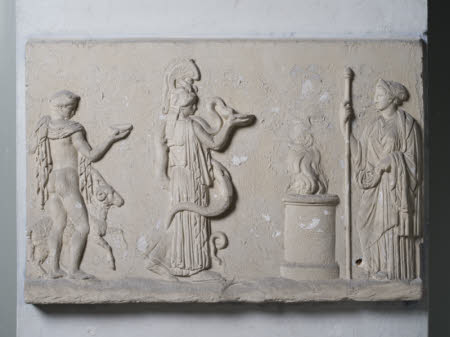Plaster cast of the deities Mercury and Minerva sacrificing to the Goddess Juno.
Category
Art / Sculpture
Date
1800 - 1825
Materials
Plaster, painted
Measurements
760 x 500 x 45 mm
Order this imageCollection
Knole, Kent
NT 128698
Summary
Minerva, the lady with the headdress and snake, presents her libation or gift in a saucer. Her serpent, like the ancient symbol of a snake eating its tail, represents victory over death. Behind her, the god Mercury brings a ram to be sacrificed; he too holds a saucer. In Roman sacrifices, sometimes only the blood of the animal was offered, while the carcass was left for the priests of the temple to eat. Juno stands before them with her staff, indicating that she is the goddess to whom the sacrifices are being offered.
Full description
The three figures on this plaster cast are from the second century Barberini chandeliers AD, formerly in the Barberini collection and now on display in the Vatican Museums. Simone Bulgarini is said to have found the candlesticks in 1630 during excavations on his property in Tivoli, southeast of the so-called Small Palace of Hadrian. He gave them to the then Cardinal Francesco Barberini (1597–1679), from whose collection they were acquired in 1766 by the art dealer Thomas Jenkins (1722–1798). Jenkins then had them restored by the sculptor Bartolomeo Cavaceppi (1716–1799) and sold them to the papal collection in 1770. The plaster cast depicts figures, which were placed separately on three sides of each chandelier, to tell a story. In this case, of a procession in which sacrifices are brought to an altar guarded by the goddess Juno.
Provenance
Possibly acquired by Charles, 1st Earl Whitworth (1752-1825)
Credit line
National Trust Collections (Knole, The Sackville Collection)
